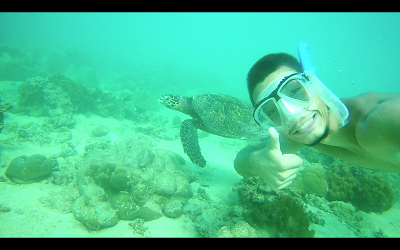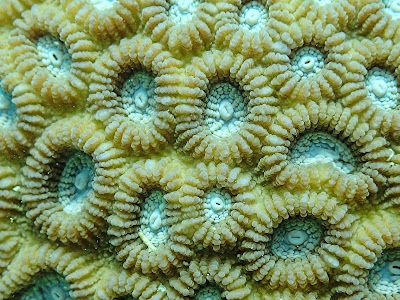A short story about corals #2
 |
This
photo has nothing to do with the topic but it attracts your curiosity “Niark
Niark” (evil laugh).
|
Hello curious reader,
Hope you are doing good and ready to dive again
in the incredible world of corals.
Last time we spoke about polyps and zooxanthellae,
remember? If not check rapidly the 1st story about corals! Don’t be
lazy, it’s worth it!
We are far to understand all the mysteries
that hide corals and we’ll probably never know them, like every nature forms.
However, let’s try to discuss about the things we know for the moment.
We’ve seen that corals are true builders. But
they are not only simple builders: they are colourful builders! Red, pink,
brown, green, yellow… they are colours for everybody! And guess where come from
all these rainbows of colours?
Yes, exactly my attentive reader! They came
from the tiny algae who live inside the polyps: the zooxanthellae (most of the
tropical hard corals possess this symbiont).
The algae give colours to the corals just like
chlorophyll does for plants. In exchange the polyps protect his precious
host with a calcareous structure. Isn’t that poetic? Like the beast
protecting the beauty, and the beauty bringing colours to embellish the beast…
But like in every fairy-tale, they are villains.
And one of this bad guy is called “rising level of CO2 in the atmosphere”
(weird name huh?). He can split into two dangerous mini-villains called: “Acidification
of the ocean” and “Global warming”. I’m sure you heard about them (someone
telling me in the ear flap that they are both send by the evillest of all: the
anthropogenic effect).
 |
| Galaxea sp coral (Chloé Pozas-Schacre) |
 |
| Hydnophora sp coral (Chloé Pozas-Schacre) |
Acidification of the Ocean
The polyps to construct a calcareous skeleton,
used as a fortress to protect him and his beauty, needs carbonate ion (CO32−). Carbon dioxide is increasing in the
atmosphere with the impact of human activities, nothing new here.
But the problem is
that our Ocean absorb a large quantity of this CO2 gas and change its chemistry.
To make it simple the Ocean became more acid and the proportion of carbonate
ions decrease drastically (for more detailed information ask for a chemist!).
Yes, you get it, they don’t have the chemical compounds to build a solid
structure! Exactly, like a snail without a shell. And what happen to a snail
without shell? (No, he is not transforming into a slug; try to focus reader) He
simply dies…
 |
| A nudibranch, Hypselodoris pulchella, in the sea which don’t have shell and don’t need to build anything. Lucky him! (Chloé Pozas-Schacre) |
Global warming
Yes, I know… “Enough
about the Global warming, since the last 50 years everybody talks about it!
Let’s make it fast! Because of The Global warming as you know, the water
temperature increase, the trick is that polyps are very sensible to change in
temperature. They get stressed and eject the zooxanthellae from their body.
This is what we called “coral bleaching”. The polyp loses his algae and so his
colours. However, there is still hope! If he adapts to the new condition (in
this case thermic one), he can absorb new zooxanthellae and retrieve a normal
coral colouration. The problem is that the change in temperature are fast and
the corals barely have time to adapt. So often the coral never find new algae
to live with and then die (for the moment scientists estimate that most of them
died after 2-3 weeks without zooxanthellae).
Kind of sad for a
love story… Can we modify the destiny of the lovers?
Maybe reader,
maybe…
To be continued!
Léopold



Comments
Post a Comment